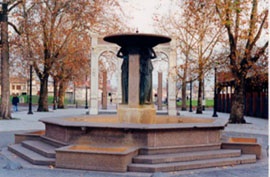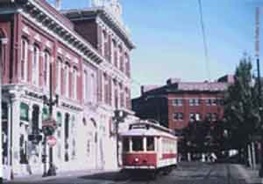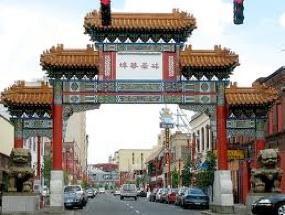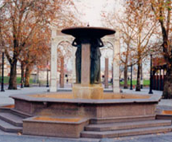- Early City Tour
- Request a Tour
Early City Pre-Tour Movie
Early City Post-Tour Movie
Click here to download a PowerPoint file named:
“Early_City_Pre-Tour_Slideshow.ppt” [10 MB].
-

The Skidmore Fountain was created in honor of Stephen Skidmore, who bequeathed $5000 in his will for a fountain where “horses, men, and dogs” could drink. Four cups chained to the pool wall could be filled from the fountain for people to drink from, but were later removed as the threat of germs became understood. The total cost of the fountain, which was erected in September 1888, five years after Stephen’s death, was not covered by his bequest. The final amount came to $18,000, so Skidmore’s family and friends made up the balance. -

The New Market Building is a fine example of the cast-iron architecture found in Old Town. Conceived by Captain A.P. Ankeny in 1872 as a covered market, the building also housed a theater and an athletic club. The first play to be performed in the theater was a musical version of Rip Van Winkle.Left to decay during the early part of the twentieth century, and used for a while as a parking garage, the New Market Building was restored to its former glory and extra office space was added in the 1980s. Now it is mostly used for government services.
-

The Japanese American Memorial Historical Plaza is a memorial to the internment of Japanese Americans during World War II. The stones bear haiku verses that tell of the history of the Japanese experience in Oregon and the names of the internment camps where Oregon’s Japanese-Americans were sent during the war. At the end of the story wall is a plaque with the official apology signed in 1988 by Congress and President Reagan. One hundred cherry trees donated by the Japanese Wheatgrowers Association surround the plaza. -

The China Gate stands at the corner of NW 4th and Burnside, marking the entry to Portland’s Chinatown. Sixty-two golden dragons decorate the gate; they are symbols of vigilance, royalty and prosperity.Guarding the gate are two bronze lions donated by Ho-Su Wuu, a Taiwanese businessman. In keeping with ancient tradition, the lion on the right (facing the gate) is the male holding the moneybag or ball; on the left is the female with her paw resting on her cub.

